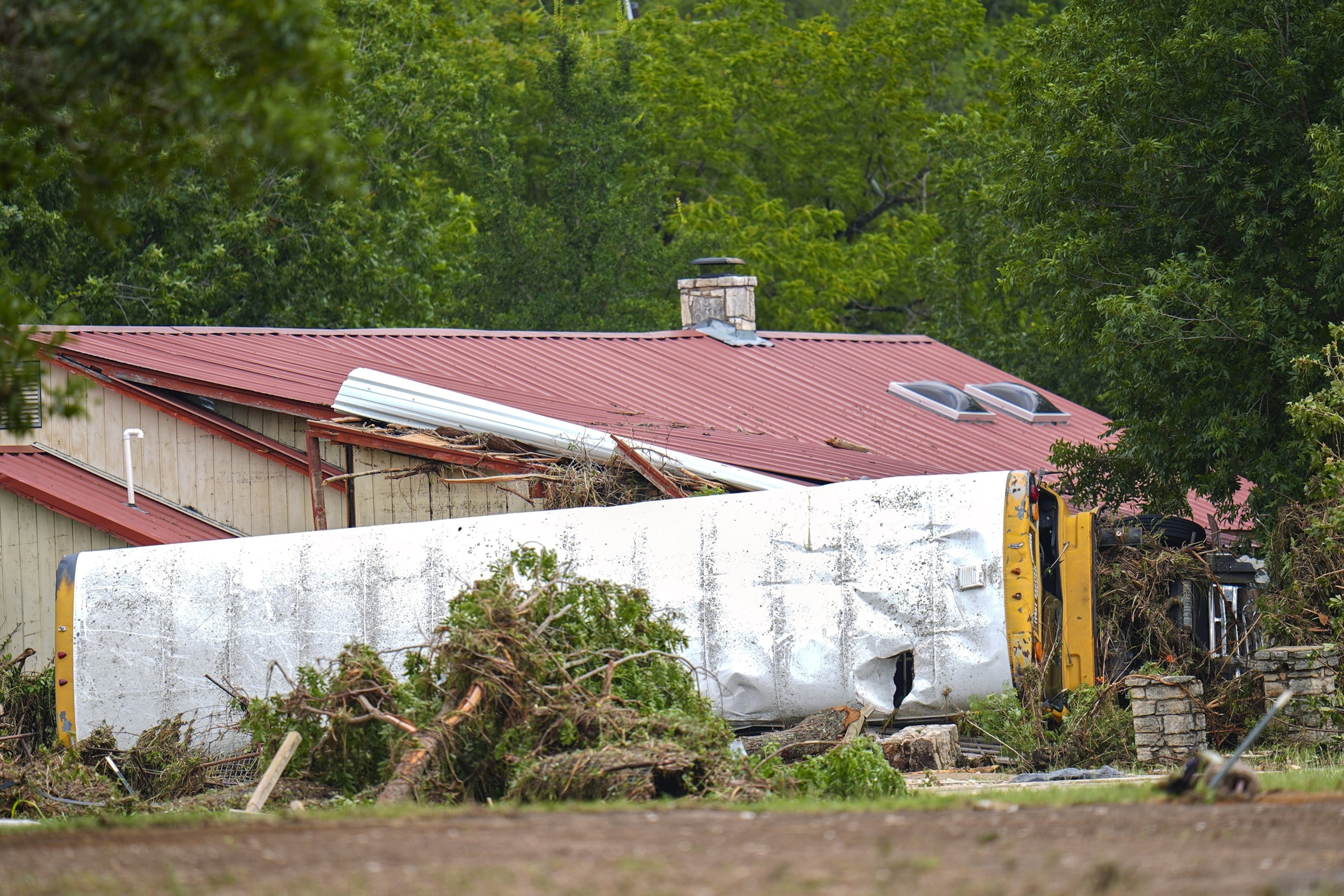How Texas' land rules allowed camps to operate in flood-prone areas
Land approvals are handled by local jurisdictions.
After deadly floods ripped through Texas last week, the state's rules and regulations about housing and construction and summer camps have come under scrutiny by some environmentalists and urban planners.
The state leaves building zoning and permits up to the individual counties. And in most non-city counties, such as Kerr, which had 96 deaths as of Thursday due to floods, some officials tend to be lenient towards building owners with restrictions, some state leaders and environmental experts told ABC News.
"In general, Texas is a state that highly values personal property rights and because of that, it is a state that is slow to change their policies to flooding," Shannon Van Zandt, a senior fellow with Texas A&M's Hazard Reduction and Recovery center, told ABC News.

The state health department, which licenses youth camps, does not directly address the risks associated with flood zones and other extreme weather for summer camps, according to state regulations.
Camps that seek approval are inspected for "fire, health, or safety hazard(s)" according to the state application form used by camps.
The form also lists that the camps' "buildings comply with applicable codes."
Twenty-seven children and staff of Camp Mystic, an all-girls sleepaway camp located on the Guadalupe River in Kerr County, were killed by the floods in the middle of the night on July 4.
A number of the cabins were in known flood zones and close proximity to the river, according to officials and FEMA's flood maps.
As of Thursday, at least 121 Texans are dead and 166 people are missing, officials said.
Van Zandt and other environmental experts said the tragedy that struck the state last week should serve as a rallying call not just for Texas, but for places around the country to reassess their building and safety rules, as the risk of more hazardous storms continues to rise.
Many state and local governments are working hard to improve building safety, Sarah Adams, an assistant professor at the University of Oregon's Environmental and Natural Resources Law Center, told ABC News.
“But communities can significantly reduce the harms and costs of flood disasters by focusing on where new homes, schools, and businesses are developed,” she said, “not just how safe the individual buildings are.”
Flood construction is discretionary in Texas
Republican Texas Rep. Gary Gates, who chairs the state House's Land & Resource Management Committee, told ABC News that outside of the major cities, there are generally no major zoning rules.
Gates said that when it comes to dwellings that are built along the coast and near flood areas, state legislators leave the discretion to "the counties and the free market system."

"The federal guidelines and FEMA set flooding zones. They rate flood zones based on different categories. The flood insurance is based on what zone you are in," he said. "Most of the jurisdictions won't allow you to build if you can't provide insurance. That's why local jurisdictions leave it up to the insurance."
Gates said there is "very little oversight" in the state for building or establishing any type of campground.
"For a river camp that is not in a city it's pretty open on what you can do," he said. "A lot of those are very primitive. They are designed where you can just park your RV there and live in a tent. It's hard to regulate when you can allow tents. How do you regulate some bare bones sleeping accommodations?"

The representative noted that in the case with Camp Mystic, which opened in 1926 and expanded throughout the years, many structures were built long before FEMA flood zones and other regulations were created and are likely to have approvals grandfathered in. This included other longstanding campsites that operated along the Guadalupe River which were also hit with floods.
Gates said camps and other properties in the flood-prone areas would likely have had protocols in place that prevented damage or injury from flooding since the Guadalupe River has had many dangerous flooding events in the last 40 years, including 1987, when a Guadalupe River flash flood overwhelmed Texas and killed 10 people.
Officials at Camp Mystic and Kerr County have not immediately returned ABC News' requests for comment about storm preparation.
"We have been in communication with local and state authorities who are tirelessly deploying extensive resources to search for our missing girls. We are deeply grateful for the outpouring of support from community, first responders, and officials at every level," the camp posted on its website.
Camp Mystic grandfathered into flood zone
Henry DeHart, interim president/CEO of the American Camp Association, which was not affiliated with Camp Mystic, said in a statement to ABC News that each camp in the country is ultimately responsible for its own safety protocols.
"Camp directors work year-round to plan for emergencies, review health and safety protocols, and prepare for site-specific risks. These can include issues such as extreme weather conditions, water safety, and ongoing medical needs for campers. Before the summer season, camps train their staff and rehearse these planned responses," he said.
Van Zandt said recent FEMA flood maps indicted that the area in Kerr where the camp was located in zones designated as a floodway, which indicates a very serious threat to floods and where construction and development are generally discouraged, or in the FEMA 100-year flood risk warning.

"I know Camp Mystic; it has been around for several decades. It will be under an old building code," she said.
Texas' Department of State Health Services signed off on the youth camp's emergency plans last week, according to records obtained by ABC News.
An inspection report dated July 2 indicates that state inspectors noted the camp had emergency plans "in case of a disaster" in place and that staff and volunteers were briefed on the plans during training sessions and volunteer briefings.
Lara Anton, a spokesperson for the Texas Department of State Health Services, told ABC News in a statement that camps are required to develop their own emergency plans, which are then assessed by the state for adherence to the Texas Administrative Code.
"The plans should include disaster, serious accident, epidemic, or fatality," Anton said. "Disaster would include flooding, tornado, etc. The inspector checked that they had plans posted for those elements in every building and that they had trained staff and volunteers on what to do."

The details of Camp Mystic's emergency plans were not included in the records released by the state. DSHS released the July 2 inspection report along with five years of reports of the youth camp.
The inspection report, which showed the youth camp complied with various regulations, concluded "there is no deficiency/violation cited or noted within the scope of this inspection/visit."
The youth camp had 557 campers and 108 staffers at the time of the inspection between the Guadalupe and Cypress Lake locations.

While the Texas' Department of State Health Services does do a thorough process of checking campsites and other buildings for flood damage using FEMA guidelines, Van Zandt, however, said that those inspections aren't enough given the flooding dangers that these camps are in.
"FEMA has a checklist approach to reviewing the plans. As long as they fit those boxes, they're fine," she said. "There is not a real assessment of the quality of the plan."
FEMA has not responded to what happened at the camp.
Rethinking building regulations, making hard decisions
Adams, who spent years researching zoning and building codes in New York City and Long Island following Superstorm Sandy, said the situation in Texas is a national problem that states and localities are struggling to solve.
She said flooding map trends have shown that more areas are now experiencing dangerous flash floods more often and at higher levels.
While relocating existing properties from flood-prone locations is difficult, and in some places impossible, due to the costs, residents’ connections to their homes and neighborhoods, and in some cases the lack of better options, Adams said local governments should find ways to steer new development away from low floodplains.
"The thing that will drive the costs of those disasters is the development that is coming right now," she said.
Camp Mystic, for example, opened a new section of the camp five years ago that is closer to Cypress Lake, which was also in the FEMA flood zone areas and affected by the flooding. Kerr County approved the expansion.

In 2011, in light of the numerous floods and rains that hit the area, Kerr county's leaders approved a flood damage prevention order that updated its flood insurance rate maps and gave updated building guidelines. Buildings constructed after the order required "methods and practices that minimize flood damage," and materials "resistant to flood damage," according to the order.
The order also prohibited encroachments in areas of special flood hazard.
Gates said the state legislature will be looking at ways to prevent the tragedy from happening again but added that he did not want to "overregulate" because of rare events. He added that while some Texas communities, like Galveston, have local regulations that mandate homes have strict wind load resistance due to the danger of tornadoes and storms, rural areas do not have the resources to fortify.
"Here it is different because when you have a flash flood event, there is very little building that can withstand that force of water," he said.
Gates said that any regulation changes could take years, but he did say that in the interim, the communities and camps could focus on improving their warning systems.
"Our warning systems weren't taken seriously enough, and that needs to change," he said.
ABC News' Laura Romero contributed to this report.



